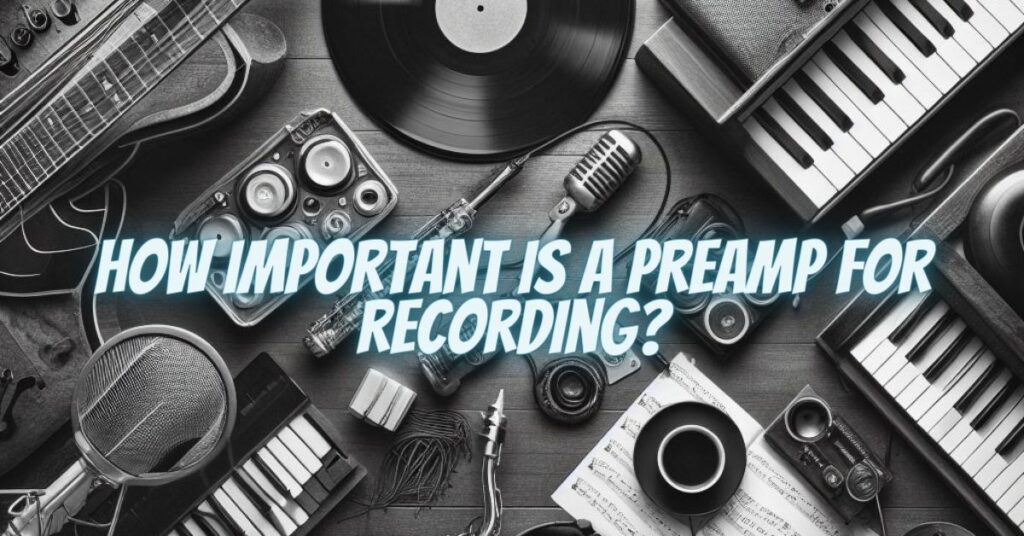In the intricate world of audio recording, the role of a preamplifier, commonly known as a preamp, stands as a linchpin in the signal chain. Often regarded as the unsung hero, the preamp plays a pivotal role in shaping the quality, character, and fidelity of the audio signal before it journeys through the recording system. This article delves into the multifaceted importance of preamps in the recording process, elucidating their impact on signal strength, tonal shaping, and overall sonic integrity.
- Signal Boosting and Voltage Amplification: At its core, a preamp is designed to boost the strength of a weak audio signal, ensuring that it reaches the recording device with optimal voltage levels. Microphones, instruments, and other audio sources produce relatively low-level signals that need to be elevated for effective processing and capturing. The preamp serves as the initial catalyst in this journey, elevating the signal to a level suitable for subsequent recording and processing stages.
- Preservation of Signal Fidelity: The importance of a preamp lies in its ability to preserve the fidelity and integrity of the original signal. High-quality preamps are engineered to introduce minimal noise, distortion, or coloration to the signal. By maintaining signal purity, preamps ensure that the recorded audio faithfully represents the nuances, dynamics, and subtleties of the source, laying the foundation for a true-to-life reproduction.
- Microphone Matching and Impedance: Different microphones exhibit varying impedance characteristics, and preamps play a crucial role in matching the impedance between the microphone and the recording system. Proper impedance matching prevents signal loss and ensures efficient signal transfer, allowing the microphone to deliver its intended sonic characteristics without compromise. This meticulous matching contributes to the overall accuracy of the recorded audio.
- Tonal Shaping and Coloration: Preamps are equipped with controls that enable users to shape the tonal characteristics of the audio signal. Adjustments to parameters such as gain, EQ, and coloration allow engineers and musicians to tailor the sound to meet specific artistic preferences or the requirements of a particular recording scenario. The ability to impart subtle tonal coloration or transparency makes preamps a versatile tool for sonic customization.
- Dynamic Range and Headroom Optimization: A critical aspect of recording is capturing the full dynamic range of a performance, from the softest whispers to the loudest peaks. High-quality preamps contribute to this by providing ample headroom and dynamic range. Adequate headroom ensures that the preamp can handle sudden increases in volume without introducing distortion, allowing for a clean and accurate representation of the audio signal.
- Integration with Various Sources: Preamps are not exclusive to microphones; they are essential for various audio sources, including instruments, synthesizers, and line-level devices. The adaptability of preamps to accommodate different sources makes them indispensable in a recording environment, allowing seamless integration of diverse elements in a musical or audio production.
- Recording Consistency and Reproducibility: Consistency is a hallmark of professional recordings, and preamps contribute significantly to achieving this goal. The use of high-quality preamps ensures a consistent and reproducible recording environment. Whether tracking multiple sessions or capturing a series of performances, the reliability and stability provided by preamps contribute to the coherence and continuity of the recorded material.
- Versatility in Recording Environments: The importance of preamps extends to various recording environments, from pristine studios to on-location recordings. In studio setups, preamps provide the foundation for crafting a signature sound, while in mobile or live recording scenarios, they ensure that the audio signal remains robust and faithful in diverse acoustic conditions.
In the realm of audio recording, the importance of preamps cannot be overstated. These unassuming devices serve as the gateway between the source signal and the recording system, exerting a profound influence on the quality, clarity, and sonic character of the captured audio. From signal boosting and tonal shaping to impedance matching and dynamic range optimization, preamps stand as indispensable tools that elevate the art and science of recording, making them an essential investment for any serious audio professional or enthusiast.


